Abstract
Solid-state electronic spins are extensively studied in quantum information science, as their large magnetic moments offer fast operations for computing1 and communication2,3,4, and high sensitivity for sensing5. However, electronic spins are more sensitive to magnetic noise, but engineering of their spectroscopic properties, for example, using clock transitions and isotopic engineering, can yield remarkable spin coherence times, as for electronic spins in GaAs6, donors in silicon7,8,9,10,11 and vacancy centres in diamond12,13. Here we demonstrate simultaneously induced clock transitions for both microwave and optical domains in an isotopically purified 171Yb3+:Y2SiO5 crystal, reaching coherence times of greater than 100 μs and 1 ms in the optical and microwave domains, respectively. This effect is due to the highly anisotropic hyperfine interaction, which makes each electronic–nuclear state an entangled Bell state. Our results underline the potential of 171Yb3+:Y2SiO5 for quantum processing applications relying on both optical and spin manipulation, such as optical quantum memories4,14, microwave-to-optical quantum transducers15,16, and single-spin detection17, while they should also be observable in a range of different materials with anisotropic hyperfine interactions.
This is a preview of subscription content, access via your institution
Access options
Access Nature and 54 other Nature Portfolio journals
Get Nature+, our best-value online-access subscription
$29.99 / 30 days
cancel any time
Subscribe to this journal
Receive 12 print issues and online access
$259.00 per year
only $21.58 per issue
Buy this article
- Purchase on Springer Link
- Instant access to full article PDF
Prices may be subject to local taxes which are calculated during checkout



Similar content being viewed by others
References
Wesenberg, J. H. et al. Quantum computing with an electron spin ensemble. Phys. Rev. Lett. 103, 070502 (2009).
Togan, E. et al. Quantum entanglement between an optical photon and a solid-state spin qubit. Nature 466, 730–734 (2010).
Gao, W. B. et al. Quantum teleportation from a propagating photon to a solid-state spin qubit. Nat. Commun. 4, 2744 (2013).
Bussières, F. et al. Quantum teleportation from a telecom-wavelength photon to a solid-state quantum memory. Nat. Photon. 8, 775–778 (2014).
Grinolds, M. S. et al. Subnanometre resolution in three-dimensional magnetic resonance imaging of individual dark spins. Nat. Nanotech. 9, 279–284 (2014).
Bluhm, H. et al. Dephasing time of GaAs electron-spin qubits coupled to a nuclear bath exceeding 200 μs. Nat. Phys. 7, 109–113 (2011).
George, R. E. et al. Electron spin coherence and electron nuclear double resonance of Bi donors in natural Si. Phys. Rev. Lett. 105, 067601 (2010).
Tyryshkin, A. M. et al. Electron spin coherence exceeding seconds in high-purity silicon. Nat. Mater. 11, 143–147 (2012).
Wolfowicz, G. et al. Atomic clock transitions in silicon-based spin qubits. Nat. Nanotech. 8, 561–564 (2013).
Lo, C. C. et al. Hybrid optical–electrical detection of donor electron spins with bound excitons in silicon. Nat. Mater. 14, 490–494 (2015).
Morse, K. J. et al. A photonic platform for donor spin qubits in silicon. Sci. Adv. 3, e1700930 (2017).
Balasubramanian, G. et al. Ultralong spin coherence time in isotopically engineered diamond. Nat. Mater. 8, 383–387 (2009).
Sukachev, D. D. et al. Silicon-vacancy spin qubit in diamond: A quantum memory exceeding 10 ms with single-shot state readout. Phys. Rev. Lett. 119, 223602 (2017).
Saglamyurek, E. et al. Quantum storage of entangled telecom-wavelength photons in an erbium-doped optical fibre. Nat. Photon. 9, 83–87 (2015).
Probst, S. et al. Anisotropic rare-earth spin ensemble strongly coupled to a superconducting resonator. Phys. Rev. Lett. 110, 157001 (2013).
Fernandez-Gonzalvo, X., Chen, Y.-H., Yin, C., Rogge, S. & Longdell, J. J. Coherent frequency up-conversion of microwaves to the optical telecommunications band in Er:YSO crystal. Phys. Rev. A 92, 062313 (2015).
Bienfait, A. et al. Reaching the quantum limit of sensitivity in electron spin resonance. Nat. Nanotech. 11, 253–257 (2016).
Fraval, E., Sellars, M. J. & Longdell, J. J. Method of extending hyperfine coherence times in Pr3+:Y2SiO5. Phys. Rev. Lett. 92, 077601 (2004).
Lovrić, M. et al. Hyperfine characterization and spin coherence lifetime extension in Pr3+:La2(WO4)3. Phys. Rev. B 84, 104417 (2011).
Zhong, M. et al. Optically addressable nuclear spins in a solid with a six-hour coherence time. Nature 517, 177–180 (2015).
Bertaina, S. et al. Rare-earth solid-state qubits. Nat. Nanotech. 2, 39–42 (2007).
Wolfowicz, G. et al. Coherent storage of microwave excitations in rare-earth nuclear spins. Phys. Rev. Lett. 114, 170503 (2015).
Rančić, M., Hedges, M. P., Ahlefeldt, R. L. & Sellars, M. J. Coherence time of over a second in a telecom-compatible quantum memory storage material. Nat. Phys. 14, 50–54 (2018).
Thiel, C., Böttger, T. & Cone, R. Rare-earth-doped materials for applications in quantum information storage and signal processing. J. Lumin. 131, 353–361 (2011).
Sun, Y., Thiel, C. W., Cone, R. L., Equall, R. W. & Hutcheson, R. L. Recent progress in developing new rare earth materials for hole burning and coherent transient applications. J. Lumin. 98, 281–287 (2002).
Böttger, T., Thiel, C. W., Cone, R. L., Sun, Y. & Faraon, A. Optical spectroscopy and decoherence sttudies of Yb3+:YAG at 968 nm. Phys. Rev. B 94, 045134 (2016).
Welinski, S., Ferrier, A., Afzelius, M. & Goldner, P. High-resolution optical spectroscopy and magnetic properties of Yb3+ in Y2SiO5. Phys. Rev. B 94, 155116 (2016).
Tiranov, A. et al. Spectroscopic study of hyperfine properties in 171Yb3+:Y2SiO5. Preprint at https://arXiv.org/abs/1712.08616 (2017).
Lim, H.-J., Welinski, S., Ferrier, A., Goldner, P. & Morton, J. J. L. Coherent spin dynamics of ytterbium ions in yttrium orthosilicate. Phys. Rev. B 97, 064409 (2018).
Dolde, F. et al. Electric-field sensing using single diamond spins. Nat. Phys. 7, 459–463 (2011).
Jamonneau, P. et al. Competition between electric field and magnetic field noise in the decoherence of a single spin in diamond. Phys. Rev. B 93, 024305 (2016).
Cruzeiro, E. Z. et al. Spectral hole lifetimes and spin population relaxation dynamics in neodymium-doped yttrium orthosilicate. Phys. Rev. B 95, 205119 (2017).
Rakhmatullin, R. M. et al. Coherent spin manipulations in Yb3+:CaWO4 at X- and W-band EPR frequencies. Phys. Rev. B 79, 172408 (2009).
Rakonjac, J. V., Chen, Y.-H., Horvath, S. P. & Longdell, J. J. Spin echoes in the ground and an optically excited state of 167Er3+:Y2SO5 at near-zero magnetic fields using Raman heterodyne spectroscopy. Preprint at https://arXiv.org/abs/1802.03862 (2018).
Zadrozny, J. M., Niklas, J., Poluektov, O. G., & Freedman, D. E. Millisecond coherence time in a tunable molecular electronic spin qubit. ACS Cent. Sci. 1, 488–492 (2015).
Shiddiq, M. et al. Enhancing coherence in molecular spin qubits via atomic clock transitions. Nature 531, 348–351 (2016).
Acknowledgements
We acknowledge funding from the Swiss FNS NCCR programme Quantum Science Technology (QSIT) and FNS research project no. 172590, EUs H2020 programme under the Marie Skłodowska-Curie project QCALL (GA 675662), EUs FP7 programme under the ERC AdG project MEC (GA 339198), ANR under grant agreement no. 145-CE26-0037-01 (DISCRYS) and NanoK project RECTUS and the IMTO Cancer AVIESAN (Cancer Plan, C16027HS, MALT).
Author information
Authors and Affiliations
Contributions
S.W., A.F. and P.G. grew the crystal sample, measured and analysed the absorption spectrum. A.T. and M.A. conceived and planned the optical and spin echo experiments, which were mainly carried out by A.O. and A.T. with contributions from S.W. and M.A. The theoretical model was developed by F.F, A.T, S.W., P.G. and M.A. The manuscript was mainly written by A.O., A.T. and M.A., with contributions from all the authors. N.G. and M.A. provided overall oversight of the project.
Corresponding author
Ethics declarations
Competing interests
The authors declare no competing interests.
Additional information
Publisher’s note: Springer Nature remains neutral with regard to jurisdictional claims in published maps and institutional affiliations.
Supplementary information
Supplementary Information
Supplementary Notes 1–3, Supplementary Figures 1–4
Rights and permissions
About this article
Cite this article
Ortu, A., Tiranov, A., Welinski, S. et al. Simultaneous coherence enhancement of optical and microwave transitions in solid-state electronic spins. Nature Mater 17, 671–675 (2018). https://doi.org/10.1038/s41563-018-0138-x
Received:
Accepted:
Published:
Issue Date:
DOI: https://doi.org/10.1038/s41563-018-0138-x
This article is cited by
-
Optical and Raman spectroscopies of 171Yb3+:Y2SiO5 hyperfine structure for application toward microwave-to-optical transducer
Journal of the Korean Physical Society (2024)
-
Quantum storage of entangled photons at telecom wavelengths in a crystal
Nature Communications (2023)
-
Indistinguishable telecom band photons from a single Er ion in the solid state
Nature (2023)
-
Coherent optical-microwave interface for manipulation of low-field electronic clock transitions in 171Yb3+:Y2SiO5
npj Quantum Information (2023)
-
Rare-earth quantum memories: The experimental status quo
Frontiers of Physics (2023)



